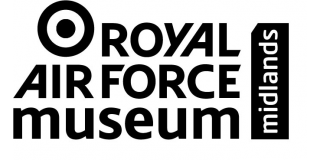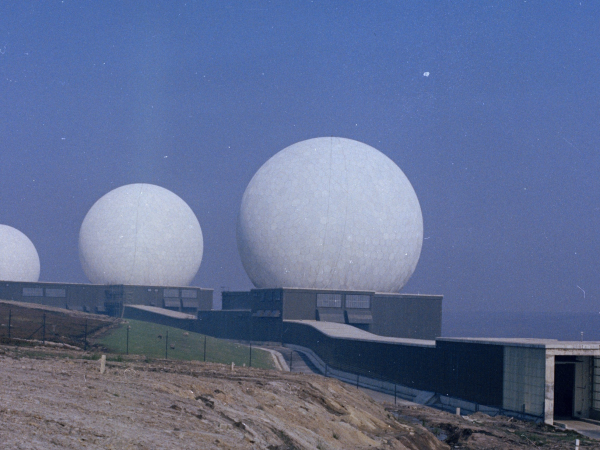Lunchtime Lecture: Of Golf Balls and Pyramids
On Tuesday 14 October 2025 at 12pm, Dr Thomas Withington will explain the decision to activate RAF Fylingdales and the role it was to perform. This lecture will be hosted virtually via Crowdcast and livestreamed from the RAF Museum's Midlands site
Talk Outline
British Cold War iconography is impressive: The Greenham Common Peace Camp, Royal Air Force V-Bombers, nuclear submarines, and Protect and Survive leaflets to name just four. One of the country’s most impressive Cold War emblems was the RAF Fylingdales early warning radar base. Situated on the picturesque North York Moors, the facility opened in 1963. It was equipped with three large ‘golf ball’ radomes housing giant radar antennas. RAF Fylingdales watched the skies for ballistic missile launches from the Soviet Union and Warsaw Pact. The radomes, visible for miles around, became a tourist attraction and a subject of controversy for peace campaigners. It was these radars that would detect an incoming nuclear strike against the UK, triggering the famous Four Minute Warning. The end of the Cold War did not spell the end of RAF Fylingdales’ mission, but did spell the end of the golf balls. These were replaced with an equally iconic pyramid-like structure housing a new radar for the same mission, watching for missile launches.
Using original documents and source materials, this lecture will explain the decision to activate RAF Fylingdales, and the mission the facility was to perform which will be described in detail. It will explain the crucial role the base had in the UK’s Warning and Monitoring Organisation. The lecture will discuss the political controversies surrounding the facility, and why Fylingdales’ mission continued after the Cold War. The lecture will conclude by discussing RAF Fylingdales’ current tasks, and the vital work it performs on the UK’s and NATO’s behalf.
About Dr Thomas Withington
Dr Thomas Withington is an award-winning analyst and writer specialising in electronic warfare, radar and military communications and a Research Associate at the Royal United Services Institute. He has written widely on these subjects for a range of specialist and general publications. He also works as a consultant and adviser in these areas for several leading government and private sector clients. Furthermore, Dr Withington provides regular commentary on security and defence aspects of electromagnetic spectrum use for major media organisations around the world.
Ticket options
On Tuesday 14 October 2025 at 12pm, Dr Thomas Withington will explain the decision to activate RAF Fylingdales and the role it was to perform. This lecture will be hosted virtually via Crowdcast and livestreamed from the RAF Museum's Midlands site
Talk Outline
British Cold War iconography is impressive: The Greenham Common Peace Camp, Royal Air Force V-Bombers, nuclear submarines, and Protect and Survive leaflets to name just four. One of the country’s most impressive Cold War emblems was the RAF Fylingdales early warning radar base. Situated on the picturesque North York Moors, the facility opened in 1963. It was equipped with three large ‘golf ball’ radomes housing giant radar antennas. RAF Fylingdales watched the skies for ballistic missile launches from the Soviet Union and Warsaw Pact. The radomes, visible for miles around, became a tourist attraction and a subject of controversy for peace campaigners. It was these radars that would detect an incoming nuclear strike against the UK, triggering the famous Four Minute Warning. The end of the Cold War did not spell the end of RAF Fylingdales’ mission, but did spell the end of the golf balls. These were replaced with an equally iconic pyramid-like structure housing a new radar for the same mission, watching for missile launches.
Using original documents and source materials, this lecture will explain the decision to activate RAF Fylingdales, and the mission the facility was to perform which will be described in detail. It will explain the crucial role the base had in the UK’s Warning and Monitoring Organisation. The lecture will discuss the political controversies surrounding the facility, and why Fylingdales’ mission continued after the Cold War. The lecture will conclude by discussing RAF Fylingdales’ current tasks, and the vital work it performs on the UK’s and NATO’s behalf.
About Dr Thomas Withington
Dr Thomas Withington is an award-winning analyst and writer specialising in electronic warfare, radar and military communications and a Research Associate at the Royal United Services Institute. He has written widely on these subjects for a range of specialist and general publications. He also works as a consultant and adviser in these areas for several leading government and private sector clients. Furthermore, Dr Withington provides regular commentary on security and defence aspects of electromagnetic spectrum use for major media organisations around the world.




